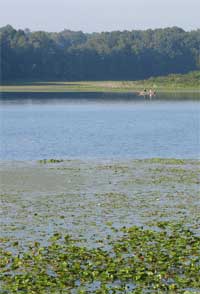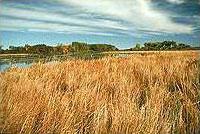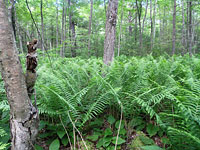Wetland Ecology and Science
Wetlands are places on the landscape where water is close to, at, or above the soil for at least part of the year. Wisconsin has over 5 million acres of wetlands, which cover 15% of the state. These wetlands provide important functions such as flood water control, water quality protection, fish and wildlife habitat and recreation for Wisconsinites.
Wetland Functional Values
Every wetland is unique and provides a diverse set of ecological services, called functional values. The functional values provided by a wetland will vary depending on its location on the landscape, land-use history, chemical and biological conditions and its physical components. Wetlands are dynamic ecosystems that change over time and may function differently from year to year or season to season.
Small wetlands provide important functional values, which are often difficult to measure if assessing a wetland in isolation from its landscape context. The report, Small Wetlands and the Cumulative Impacts of Small Wetland Losses (May 1998), presents literature relevant to assessing the functions of small wetlands including consideration of wetland complexes, local wetland scarcity, fragmentation and the cumulative impact of small wetland losses.
Determining values
Standardized assessment methods are used to evaluate the extent to which a specific wetland may perform any given function. The presence or absence of specific characteristics is used to determine the importance of each functional value for the site in question. These characteristics may or may not be obvious to the casual observer. The changing nature of wetlands can hide many of these traits. Migratory bird use, for example, is not always obvious except in spring and fall. And the occurrence of various wetland plants gives important, yet subtle, clues about habitat, water quality and biodiversity. These types of observations help us evaluate a wetland’s intrinsic value and overall importance to society.
Floral diversity
Wetlands can support an abundance and variety of plants, ranging from duckweed and orchids to black ash. These plants contribute to the earth’s biodiversity and provide food and shelter for many animal species at critical times during their life cycles. Many of the rare and endangered plant species in Wisconsin are found in wetlands.
The importance of floral diversity in a particular wetland is usually related to two factors. First, the more valuable wetlands usually support a greater variety of native plants (high diversity), than sites with little variety or large numbers of non–native species. Second, wetlands communities that are regionally scarce are considered particularly valuable.
Fish and wildlife habitat
Many animals spend their whole lives in wetlands; for others, wetlands are critical habitat for feeding, breeding, resting, nesting, escape cover or travel corridors. Wisconsin wetlands are spawning grounds for northern pike, nurseries for fish and ducklings, critical habitat for shorebirds and songbirds and lifelong habitat for some frogs and turtles. Wetlands also provide essential habitat for smaller aquatic organisms in the food web, including crustaceans, mollusks, insects, and plankton.
Some of the most valuable wetlands for fish and wildlife provide diverse plant cover and open water within large, undeveloped tracts of land. This function may be considered particularly important if the habitat is regionally scarce, such as the last remaining wetland in an urban setting.
Flood protection
Due to dense vegetation and location within the landscape, wetlands are important for retaining stormwater from rain and melting snow rushing toward rivers and lakes. Wetlands slow stormwater runoff and can provide storage areas for floods, thus minimizing harm to downstream areas.
Preservation of wetlands can prevent needless expenses for flood and stormwater control projects such as dikes, levees, concrete-lined channels and detention basins.
Wetlands located in the mid or lower reaches of a watershed contribute most substantially to flood control since they lie in the path of more water than their upstream counterparts. When several wetland basins perform this function within a watershed, the effect may be a staggered, moderated discharge, reducing flood peaks.
Flood protection may be especially important in cities, where pavement contributes to runoff, and in areas with steep slopes or other land features which tend to increase stormwater amounts and velocity. These functional values can provide economic benefits to downstream property owners and taxpayers.
Water quality protection
Wetland plants and soils have the capacity to store and filter pollutants ranging from pesticides to animal wastes. Calm wetland waters, with their flat surface and flow characteristics, allow particles of toxins and nutrients to settle out of the water column. Plants take up certain nutrients from the water. Other substances can be stored or transformed to a less toxic state within wetlands. As a result, our lakes, rivers and streams are cleaner and our drinking water is safer.
Larger wetlands and those which contain dense vegetation are most effective in protecting water quality. If surrounding land uses contribute to soil runoff or introduce manure or other pollutants into a watershed, the value of this function may be especially high.
Wetlands that filter or store sediments or nutrients for extended periods may undergo fundamental changes. Sediments will eventually fill in wetlands and nutrients will eventually modify the vegetation. Such changes may result in the loss of this function over time.
Shoreline protection
Shoreland wetlands act as buffers between land and water. They protect against erosion by absorbing the force of waves and currents and by anchoring sediments. Roots of wetland plants bind lakeshores and streambanks, providing further protection. Benefits include the protection of habitat and structures, as well as land which might otherwise be lost to erosion. This function is especially important in waterways where boat traffic, water current and/or wind cause substantial water movement that would otherwise damage the shore.
Trout streams and other high-quality waterways often depend on shoreland wetlands to protect their characteristic clear, cold waters. Without this wetland buffer, the shoreline becomes undercut and collapses. When this happens, streams often become wider, shallower and turbid. Water temperatures rise and habitat quality deteriorates.
A wetland that reduces erosion can also reduce sedimentation to nearby waterways. If the waterway is a navigational channel, the reduction in sedimentation can help reduce the frequency of dredging to maintain the channel.
Groundwater recharge and discharge
Groundwater recharge is the process by which water moves into the groundwater system. Although recharge usually occurs at higher elevations, some wetlands can provide a valuable service of replenishing groundwater supplies. The filtering capacity of wetland plants and substrates may also help protect groundwater quality.
Groundwater discharge is the process by which groundwater is discharged to the surface. Groundwater discharge is a more common wetland function and can be important for stabilizing stream flows, especially during dry months. Groundwater discharge through wetlands can enhance the aquatic life communities in downstream areas. It also can contribute toward high-quality water in lakes, rivers and streams. In some cases, groundwater discharge sites are obvious, through visible springs or by the presence of certain plant species.
Aesthetics, recreation, education and science
Do you like to canoe or cross–country ski? Watch birds or listen to bullfrogs? Wetlands are some of our favorite places to study, hike or just drive by. They provide peaceful open spaces in landscapes that are under development pressure and have rich potential for hunters and anglers, scientists and students.
Wetlands provide exceptional educational and scientific research opportunities because of their unique combination of terrestrial and aquatic life and physical and chemical processes. Many species of endangered and threatened plants and animals are found in wetlands.
Wetlands located within or near urban settings and those frequently visited by the public are especially valuable for the social and educational opportunities they offer. Open water, diverse vegetation, and lack of pollution also contribute to the value of specific wetlands for recreational and educational purposes and general quality of life.
Types of Wetlands in Wisconsin
Wisconsin has wide range of specific wetland types – from shallow ponds to dense forests, from vast meadows to narrow urban drainageways. Wetlands generally come in one of four broad structural types:
Submerged or aquatic wetlands
Aquatic bed wetlands have plants growing entirely on or in a water body no deeper than 6 feet. Plants may include pondweed, duckweed, lotus and water–lilies.
Marshes are characterized by standing water and dominated by cattails, bulrushes, pickerelweed, lake sedges and/or giant bur–reed.
Herbaceous wetlands
Sedge or wet meadows more often than not have saturated soils rather than standing water. Sedges, grasses and reeds are dominant, but may also have forbs and wildflowers such as blue flag iris, marsh milkweed, sneezeweed, mint and several species of goldenrod and aster.
Shrub/scrub wetlands
These areas, which alder thickets and sometimes bogs, are characterized by woody shrubs and small trees such as tag alder, bog birch, willow and dogwood.
Forested wetlands
There are a wide variety of forested wetlands, including bogs and forested floodplain complexes, and they are characterized by trees 20 feet or more in height such as tamarack, white cedar, black spruce, elm, black ash, green ash and silver maple.
Herbaceous, shrub/scrub, and forested communities can all range from very wet with standing water through part of the year to communities that appear dry for much of the year.
To better understand these wetland community types and how to identify them see these resources:
- DNR Natural Heritage Conservation wetland community descriptions and key
- Wetland Plants and Plant Communities of Minnesota and Wisconsin – publication by Steve Eggers and Donald Reed
Wetland Invasive Species
Wetland communities in Wisconsin have been invaded by problematic non-native species for decades. To learn more about wetland invasive species identification, invasive species management tactics, or Wisconsin's regulated and non-regulated plants and animals, you can visit the Regulated Species pages. The public is encouraged to report new or spreading invasive species.
To learn more about some of Wisconsin's most common wetland invasive species, visit the following webpages:
- Common Wetland Invasive Plants of Wisconsin
- Common Reed (Phragmites australis)
- Reed Canary Grass (Phalaris arundinacea)
- Narrow-leaf Cattail & Hybrid Cattail (Typha angustifolia & T. x glauca)
- Purple Loosestrife (Lythrum salicaria)
Wetlands and Wildlife
Wetlands are an important resource for many of Wisconsin's wildlife species, from providing nesting habitat to providing important food sources. In addition, some of Wisconsin's most cherished recreational pastimes rely on healthy wetlands throughout the landscape to support wildlife populations.
Additional information about wetland wildlife, can be found at the following links:







